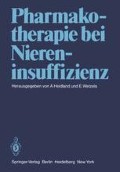Abstract
The persistence of a drug in the body following its absorption depends on factors such as biotransformation, protein binding, sequestration in various organs in the body compartments and excretion into bile, feces and urine. The kidney is the principal organ for termination of drug action via excretion for many commonly used drugs. If a drug is removed from the body mainly via renal elimination, then modification of drug therapy is critical in azotemic patients to insure adequate treatment without producing toxicity [1–3]. As demonstrated in the studies of Richet, de Novales and Verroust [4] and Smith, Seidl and Cluff [5], the incidence of adverse drug reactions is greater in azotemic patients. Ideally, dosage modification in azotemic patients would produce plasma concentration peaks and nadirs which closely mimic those obtained in patients without renal failure. Such an ideal is rarely obtained. However, reasonable clinical goals can be obtained, as the renal elimination of most drugs is closely related to a measure of glomerular filtration rate (GFR) such as the endogenous creatinine clearance [3]. In functionally anephric or anuric patients, drug elimination via non-renal routes and through dialysis (hemo- or peritoneal) becomes paramount.
Supported in part by a grant (RR-133) and the CLINFO Computer System (RR-37) from the General Clinical Research Centers Program of the Division of Research Resources, National Institutes of Health, and by the National Institutes of Health-National Institute of Allergy, Metabolic, and Digestive Diseases, Contract NO1-AM-2–2219
Access this chapter
Tax calculation will be finalised at checkout
Purchases are for personal use only
Preview
Unable to display preview. Download preview PDF.
References
Bennett WM, Singer I, Golper T, Feig P, Coggins CJ (1977) Guidelines for drug therapy in renal failure. Ann Intern Med 86:754–783
Anderson RJ, Gambertoglio JG, Schrier RW (1976) Clinical use of drugs in renal failure. Thomas, Springfield (Ill)
Dettli L (1977) Elimination kinetics and dosage adjustment of drugs in patients with kidney disease. Progr Pharmacol vol I, No 4
Richet G, Novales EL de, Verroust P (1970) Drug intoxication and neurological episodes in chronic renal failure. Br Med J 2:394–395
Smith JW, Seidl LG, Cluff LE (1966) Studies on the epidemiology of adverse drug reactions: V. Clinical factors influencing susceptibility. Ann Intern Med 65:629–656
Wagner SC, Pernarowski M (1971) Biopharmaceutics and relevant pharmacokinetics. Drug Intelligence Publ, Hamilton (Ill)
Tozer TN (1974) Nomogram for modification of dosage regimens in patients with chronic renal function impairment. J Pharmacokinet Biopharm 2:13–28
Reidenberg MM (1977) The binding of drugs to plasma proteins and the interpretation of measurements of plasma concentrations of drugs in patients with poor renal function. Am J Med 62:466–470
Simons KJ, Levy RH, Cutler RE, Christopher TG, Lindner A (1975) The pharmacokinetics of procainamide in normal subjects using a specific gas chromatographic assay. Res Commun Chem Pathol Pharm 11:173–185
Cutler RE, Blair AD (1978) Pharmacokinetic studies in chronic renal disease and hemodialysis. 11th Annual Contractor’s Conference, Artificial Kidney-Chronic Uremia Program, p 97
Winchester JF, Gelfand MC, Knepshield JH, Schreiner GE (1977) Dialysis and hemoperfusion of poisons and drugs — update. Trans Am Soc Artif Intern Organs 23:762–842
Babb AL, Popovich RP, Farrell PL, Blagg CR (1972) The effect of erythrocyte mass transfer rates on solute clearance measurements during hemodialysis. Proc Eur Dial Transplant Assoc 9:303–321
Christopher TG, Blair AD, Forrey AW, Cutler RE (1976) Hemodialyzer clearances of gentamicin, kanamycin, tobramycin, amikacin, ethambutol, procainamide, and flucytosine, with a technique for planning therapy. J Pharmacokinet Biopharm 4:427–441
Author information
Authors and Affiliations
Editor information
Editors and Affiliations
Rights and permissions
Copyright information
© 1980 Springer-Verlag Berlin Heidelberg
About this paper
Cite this paper
Cutler, R.E., Blair, A.D. (1980). Drug Therapy in Renal Insufficiency and During Dialytic Treatment. In: Heidland, A., Wetzels, E. (eds) Pharmakotherapie bei Niereninsuffizienz. Springer, Berlin, Heidelberg. https://doi.org/10.1007/978-3-642-67676-5_2
Download citation
DOI: https://doi.org/10.1007/978-3-642-67676-5_2
Publisher Name: Springer, Berlin, Heidelberg
Print ISBN: 978-3-540-10101-7
Online ISBN: 978-3-642-67676-5
eBook Packages: Springer Book Archive

